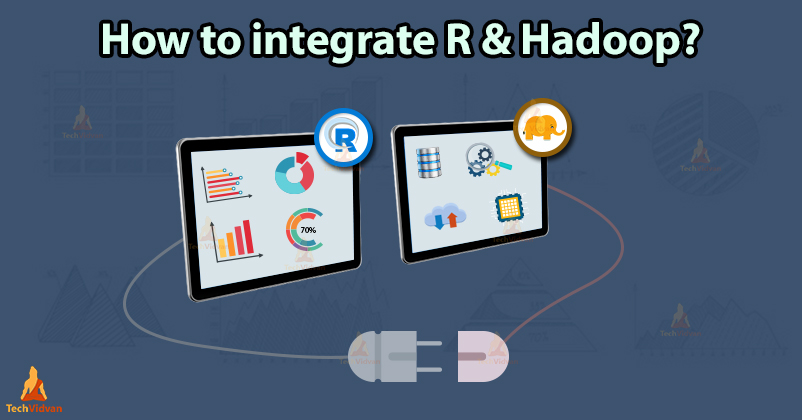R Hadoop Integration – The perfect tag team for Data Science
R is the primary tool for data scientists and data analysts when it comes to big data. It may be perfect for a lot of data science tasks, but it falls short when it comes to memory management and processing large data sets (petabyte-scale).
R needs the data to be present in the current machine’s memory. You can use R packages for distributed computing. But you need to load the data into the memory first before the packages can distribute the data to other nodes.
What to do when the data set is larger than a single node’s memory?
Well, Hadoop is here to save the day!
What is Hadoop?
Hadoop is an open-source technology for storing large quantities of data at a cheap cost. It was created by the Apache Software Foundation.
Hadoop can store and process large data sets, in a distributed fashion, in a scalable cluster of computer servers. It can process structured and unstructured data. This gives the users flexibility in collecting, processing and analyzing the data.
Why use R with Hadoop?
R is a statistical programming language and a powerful tool for analytics and visualization. Unfortunately, it fails when it comes to truly large data sets.
Hadoop is an analytics tool for distributed data processing that has virtually no limit on scalability. Yet, its capability for statistical analysis and visualization is little to non-existent.
Both technologies didn’t go hand-in-hand earlier. But with the rise of packages like RHIVE, RHIPE, and RHadoop, the two different technologies can now team up to complement each other.
The analytical power and strong graphical capabilities of R and the storage and processing power of Hadoop give the ideal solution for Big Data analytics.
How to integrate R and Hadoop?
You can use R scripts or packages used for data processing with Hadoop. To do this, one needs to rewrite these scripts or packages in Java or any other language that can work with Hadoop. This can be a complicated process. It may result in unexpected errors and might not always be possible.
Therefore, we need R based software. But we need to store the data on the Hadoop distributed storage.
Here, are some commonly used methods for R Hadoop integration:
1. RHadoop
RHadoop allows you to directly consume data from the Hbase database and the HDFS file system. Developed by Revolution analytics, it is the most common way to integrate R with Hadoop. RHadoop is a collection of five different packages that lets Hadoop users analyze data using the R programming language. These packages are:
- rhbase – It provides database manipulation and management facilities for Hbase within R. It uses the Thrift server. We need to install it on the node that runs the R client. You can read, write and modify data in the Hbase database system from R.
- plyrmr – It allows R to perform common data manipulation operations on very large data sets stored on Hadoop. It relies on the Hadoop MapReduce to complete its tasks while hiding a lot of MapReduce details.
- rmr2 – It let the R user perform statistical analysis using the Hadoop MapReduce functionality.
- rhdfs – It gives access to the data stored in the Hadoop Distributed Filesystem (HDFS) within R.
- ravro – It allows R to read and write Avro files on the HDFS file system. It also adds the Avro input format for rmr2.
2. Rhive
Hive provides a database query interface to Hadoop. Hive lets you extract data from Hadoop using SQL like queries without writing Java code. It translates an input program written in HiveQL to one or more Java MapReduce jobs. It then organizes the data into tables for the HDFS and runs the jobs on a cluster to get the desired results.
Rhive provides a connection between R and hive. It extends HiveQL with R-specific functions and adds R’s rich statistical libraries and algorithms to it. With Rhive functions, you can use HQL to apply R’s statistical functions and model to the data in a Hadoop cluster.
3. Rhipe
Rhipe or R and Hadoop Integrated Programming Environment is an R package that lets you use Hadoop from R.
It uses the map and reduce functions written in R and converts them into Hadoop map and Hadoop reduce functions. It uses the Divide-and-Recombine technique which divides data into smaller subsets and processed parallelly. After that, the output is combined.
4. ORCH
ORCH stands for Oracle R Connector for Hadoop. Oracle big appliances or other non-oracle Hadoop clusters use it. Mapper and reducer functions are written in R and executed from the R environment using a high-level interface.
5. Hadoop Streaming
Hadoop Streaming is a Hadoop utility that lets the user run MapReduce jobs with any executable script as the mapper and/or reducer. This allows the execution of Hadoop MapReduce jobs written in languages other than Java.
Thus, the Hadoop Streaming API can be used with R scripts. The streaming jobs are launched through the Hadoop command line and, therefore, don’t need any client-side integration.
Summary
Integrating R with Hadoop clusters is a very common trend in the industry today. There are various approaches available for R Hadoop integration. Hadoop Streaming seems to be the most commonly used. This is due to no requirement for client-side integration. It also has the advantage of working in a robust Hadoop environment.
While both technologies may not have much in common, they both bring the best of both worlds to form the dream team of data analytics.
R has strong analytical and visual powers. Hadoop provides a low cost yet virtually endless data storage and processing capacity. This makes their association the ideal solution for big data analytics.
Any queries in the R Hadoop integration article? Ask our TechVidvan experts in the comment section below.

